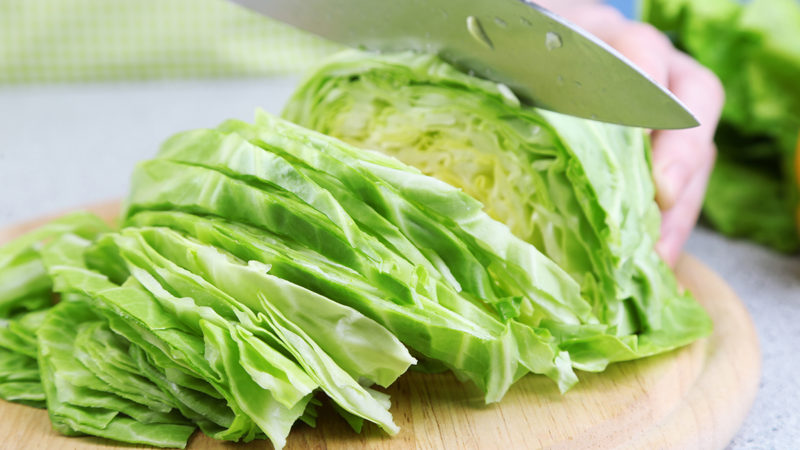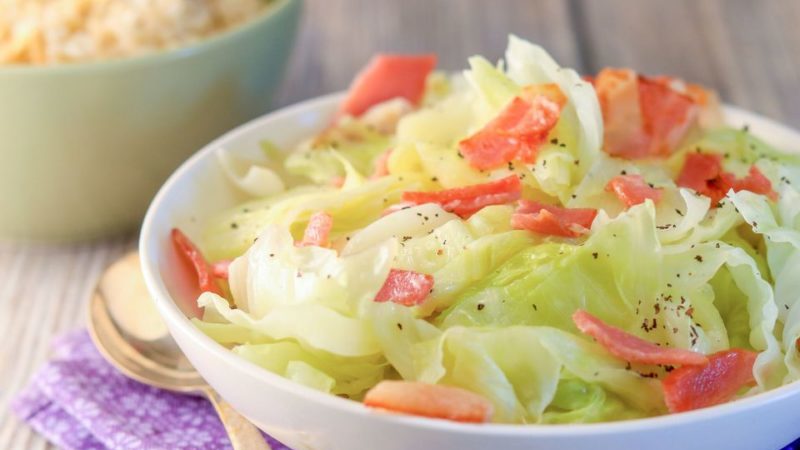The chemical composition and calorie content of boiled cabbage, the rules for its preparation
Boiled cabbage is a hypoallergenic and low-calorie product that retains up to 70% of vitamins and minerals. Due to this property, leafy vegetables are included in the diet for dietary nutrition, during pregnancy and lactation. Cabbage improves the functioning of the gastrointestinal tract, stabilizes hormones and acid-base balance.
The content of the article
Calorie content of boiled cabbage
The product has a low energy value, which allows it to be used during weight loss and when cleansing the intestines.
Glycemic index
The glycemic index of boiled cabbage is 15 units, so it is allowed to use it for diabetes.
The product does not cause a sharp increase in glucose concentration: the sugars in the leaves are destroyed during heat treatment. The bulk of carbohydrates are coarse fiber.
BZHU
Nutritional value per 100 g is:
- 1.27 g protein;
- 0.06 g fat;
- 3.61 g of carbohydrates.
The latter are presented in the form of plant fibers. There are no sugars in cabbage.
Reference! The structure of vegetable fats includes mono- and polyunsaturated fatty acids. They are not deposited in the form of glycogen in the liver, visceral and subcutaneous fat, they stimulate metabolism.
Vegetable proteins in cabbage are easily digestible, and are later used as a building material for skeletal muscles.
Composition and properties
The chemical composition of boiled cabbage includes:
- Coarse fiber. Helps cleanse the gastrointestinal tract from toxins, excess fluid and toxic components. Dietary fiber is practically not digested under the action of hydrochloric acid, therefore, they push the food lump, accelerating its excretion from the body. Fiber suppresses appetite for 2-3 hours, enhances the peristalsis of the smooth muscles of the intestinal tract.
- Macronutrients: calcium, magnesium, sodium, potassium, phosphorus, chlorine. Water-electrolyte and acid-base balances are normalized. Phosphorus and calcium strengthen the bone structure of the musculoskeletal system. Magnesium improves muscle contractility.
- Trace elements: iron, zinc, copper, fluorine, aluminum, cobalt. Iron increases serum hemoglobin levels, reduces the risk of hypoxia. Zinc has antioxidant properties, removes free radicals from the body, which cause oxidation, cell death, and accelerate the aging of the body.
- Vitamins: group B, retinol, ascorbic acid, tocopherol, biotin, choline. They improve the functioning of the endocrine glands, reduce the risk of developing cardiovascular pathologies, and support the activity of the immune system.
In addition to vitamins and mineral compounds, the product contains starch, ash, organic acids and tannins.
How many calories in 100 g
The energy value of 100 g of boiled cabbage is 23 kcal.
The calorie content of a cooked product is reduced in comparison with a raw vegetable, because part of the nutrients is destroyed during heat treatment.
Is it possible to eat boiled cabbage for losing weight
During the period of adherence to a low-calorie diet, it is not prohibited to eat boiled cabbage. The product has a low energy value, satisfies hunger for 2-3 hours and speeds up metabolism. During slimming the body is under stress due to a poor diet. Cabbage replenishes the supply of nutrients.
The vitamins contained in the product improve metabolic processes in tissues, enhance microcirculation, and normalize hormonal levels and emotional state. Fiber increases the rate of digestion and assimilation of food in the gastrointestinal tract, stabilizes stool excretion.

During pregnancy and lactation
Boiled cabbage is a hypoallergenic product, therefore it is not prohibited for use during the period of gestation and breastfeeding. In the latter case, the vegetable saturates mother's milk with vitamins and minerals. They do not provoke the development of allergies or dyspeptic disorders in infants.
During pregnancy, cabbage is consumed at 100 g per day. In the third trimester, it is better not to abuse the product: 50 g per day 1-2 times a week is enough. This limitation is due to the high content of plant fiber.
In the last 3 months of pregnancy, the fetus greatly increases in size, squeezes the organs in the abdominal cavity, especially the intestines. High amounts of dietary fiber can cause constipation.
Benefit and harm
Boiled White cabbage brings such benefits to the body:
- accelerates metabolism, helps to reduce excess body weight;
- due to the high content of ascorbic acid, it improves the functioning of the immune system, strengthens the walls of blood vessels, reduces the risk of developing infectious diseases in the autumn-winter period;
- vitamin A improves the performance of the visual analyzer;
- organic acids and dietary fiber suppress the activity of pathogenic microorganisms in the gastrointestinal tract;
- antioxidants (zinc, vitamins E and K) remove free radicals from the body, suppress inflammation of soft tissues, improve the condition of hair, nails, and restore skin elasticity;
- vitamins and minerals increase the rate of absorption of food in the small intestine;
- flavonoids reduce the risk of developing cardiovascular pathologies, stabilize blood pressure.
The product is harmful when used in excessive quantities. In this case, there is a risk of side effects:
- increased gas production in the intestines;
- flatulence;
- feeling of heaviness, bloating;
- the development of hyperacid gastritis and ulcers of the gastrointestinal tract;
- stool disorder, constipation.
How to cook properly

Cabbage leaves are boiled in different ways, depending on the type of dish:
- for vegetable salad, cabbage rolls are poured with boiling water;
- for the first courses (cabbage soup, borscht), they are pre-washed in clean water, crushed, poured with boiling water and boiled before adding other ingredients;
- the classic way: boil in water after boiling for 10-15 minutes;
- purple cabbage for salad is made with a small amount of apple cider vinegar, which helps preserve the color of the vegetable.
The maximum amount of nutrients is obtained from dense heads of cabbage of light green color. On the surface of the leaves there should be no brown, black spots, deformation, signs of mold. The leaf plate should not be sluggish and slippery to the touch.
Reference! The smaller the size of the head, the faster the leaves are boiled. The tough stump is not eaten. It often accumulates nitrates and toxic components from the soil.
The vegetable is prepared according to the following algorithm:
- Choose a cooking container and fill it with water. Add salt if necessary. Wait for the liquid to boil. It is better to put the saucepan over high heat.
- The cabbage is washed, the outer damaged leaves are separated.
- On a cutting board, the head of cabbage is cut into 2 parts, the stump is removed. Leaves, if required, are crushed.
- Cabbage is placed in boiling water, boiled for 10-15 minutes over medium heat. If you plan to cook a vegetable in a double boiler, it will take 20 minutes in Vegetable mode. Salt and spices are added beforehand. In a multicooker, cabbage is cooked for 20-25 minutes, in a pressure cooker - 15 minutes.
- After this time, the liquid is drained from the pan.
After cooking, the cabbage, if desired, is sprinkled with lemon juice, poured with olive oil, caraway seeds are added, and seasoned with vinegar. Food additives will help improve the taste of the product.

It is interesting:
How is sauerkraut juice useful for the face and how to prepare various masks with it.
Why is Romanesco cabbage useful, how it looks in the photo, is it difficult to grow it.
What's healthier: sauerkraut or pickled cabbage, and how they differ.
Consumption rates per day
For maximum benefit, it is recommended to consume no more than 150 grams of cabbage per day. If a vegetable is introduced into a children's diet, the first time the child is given no more than 30 g of leaves. Gradually, the daily rate is increased to 70-90 g.
Contraindications
Boiled cabbage is not recommended for:
- pancreatitis in chronic and acute form;
- peptic ulcer of the stomach and duodenum in the acute stage;
- individual intolerance;
- hereditary predisposition to allergy to cruciferous vegetables;
- cholecystitis;
- gout;
- recent abdominal surgery.
The product should not be given to children under 3 years of age.
Important! It is not recommended to introduce boiled cabbage as a complementary food, since due to the high content of coarse fiber, the vegetable leads to the development of constipation in infants, intestinal colic and bloating.
Conclusion
Boiled cabbage is cooked in boiling water for 10-15 minutes until softened. Most of the vitamins and minerals are retained during heat treatment. Nutrients improve metabolism, stabilize the functioning of internal organs and systems. It is not recommended to abuse the vegetable - this leads to constipation, increased gas production in the intestines.